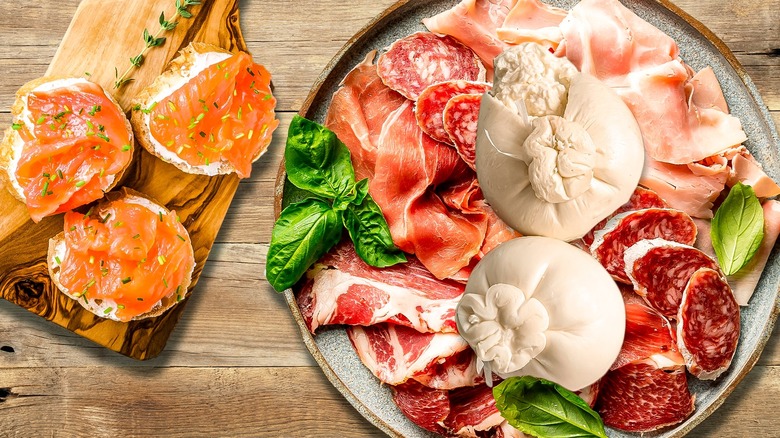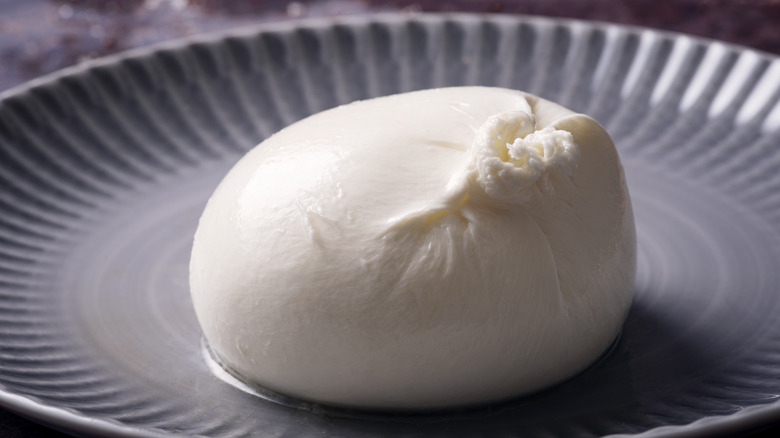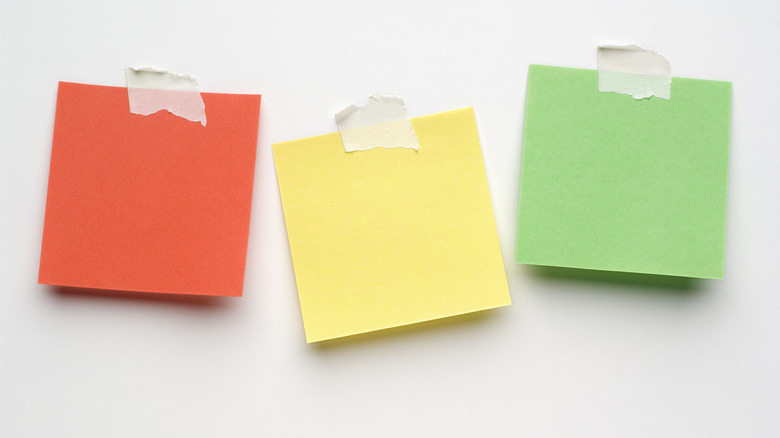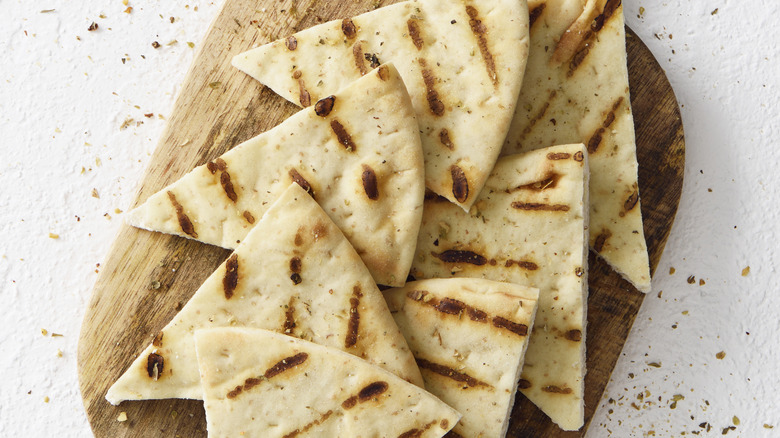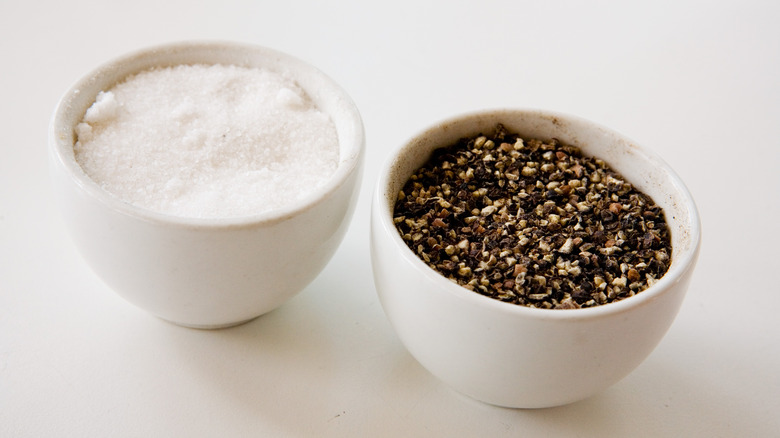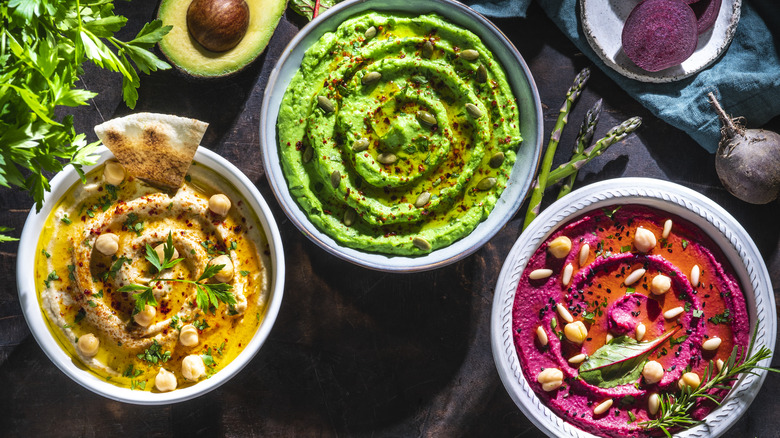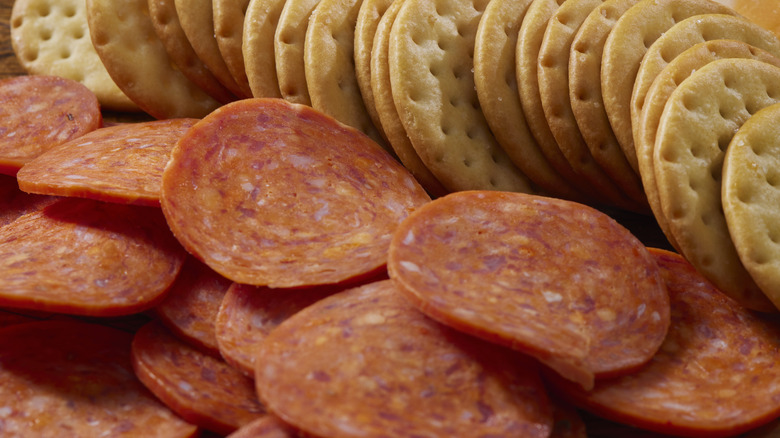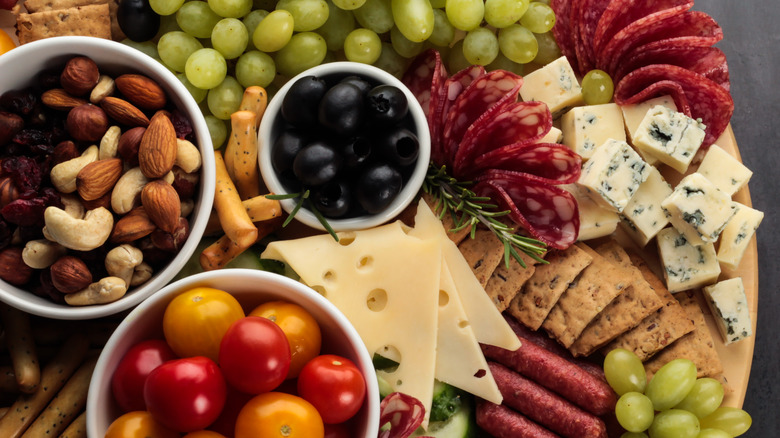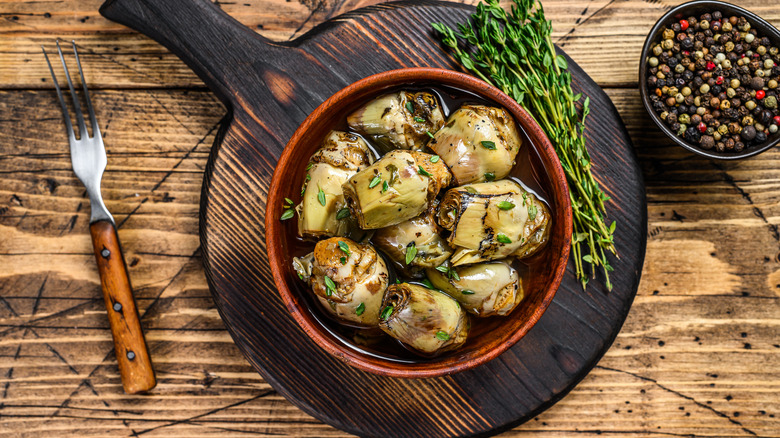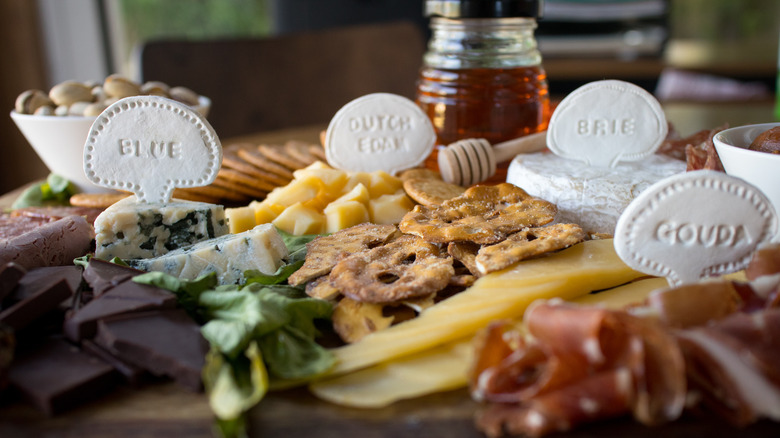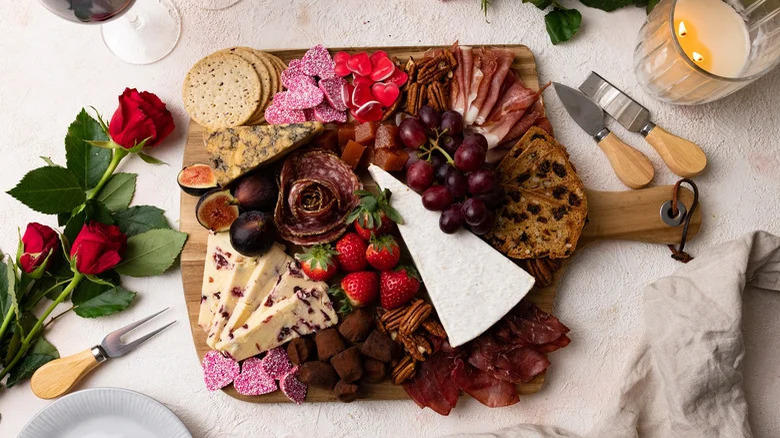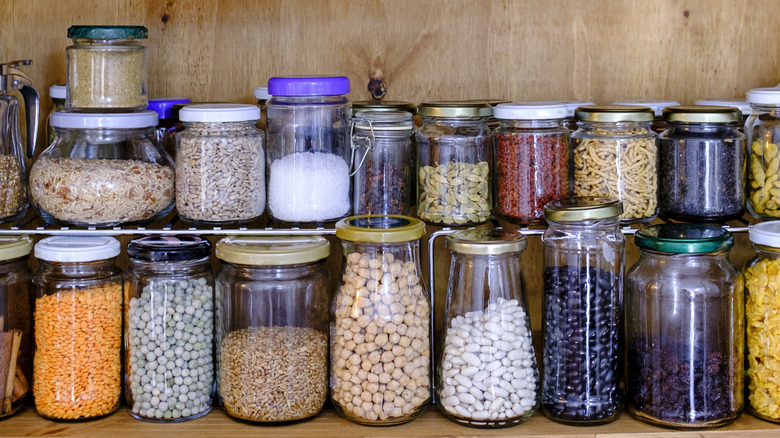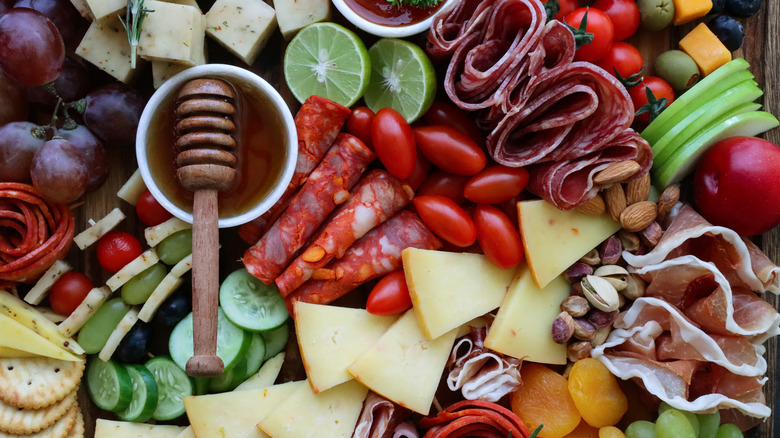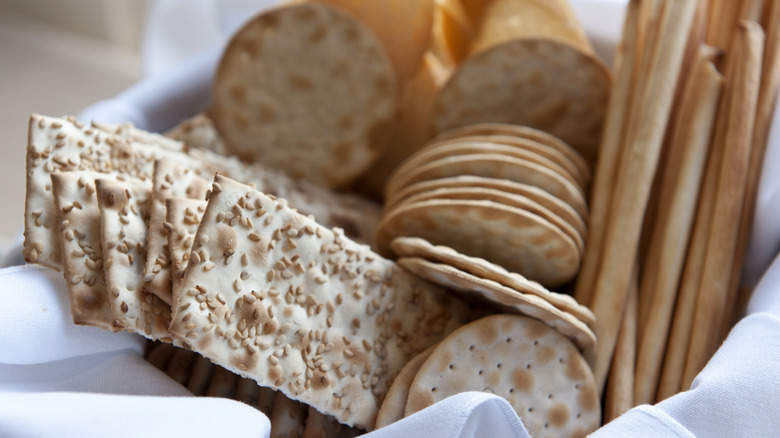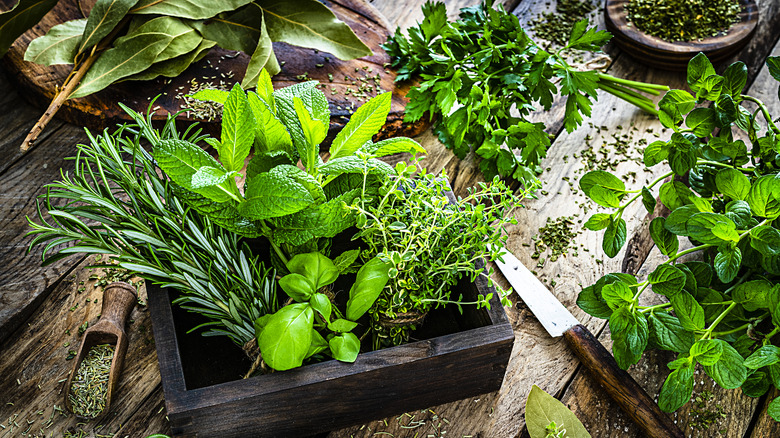16 Tips For Crafting A Better Burrata Board
If you are a fan of mozzarella, there is a good chance you're a fan of burrata. The cool sister of mozzarella, burrata is a fun addition to any charcuterie platter, appetizer dish, or salad. Burrata is mozzarella filled with stracciatella, a smooth and rich cheese made of mozzarella curds and cream. When it comes to pairing a cheese with marinated vegetables, toasted breads, cured meats, fresh stone fruits, and beyond, burrata fits the bill. No wonder burrata boards are so beloved.
Whether you want to make a quick snack assortment for a casual night in or plan an elaborate arrangement to entertain guests at your next gathering, a burrata board is sure to satisfy. What's more, there's plenty of room for creativity when making any grazing board, and a number of tricks and tips that can take your board to the next level. From serving burrata at room temperature to making a themed board for a holiday, you may want to take these pointers into consideration.
Serve burrata at room temperature
The best way to serve burrata cheese is at room temperature. This delicate cheese has subtle flavors that are best enjoyed when at room temperature rather than ice cold. However, with that in mind, you don't want to keep it out for hours on end — it's a cheese product, after all. As FoodSafety.gov advises, perishable foods — such as soft cheeses — shouldn't be left out for more than two hours.
To make sure the burrata is just right, you will want to take it out about 30 minutes before serving. If your burrata is the main or only cheese on your burrata board, make sure you give the cheese enough time to sit out before you're ready to set out all of the snacks. If you do have other cheeses on the board, feel free to replenish the first burrata once it is eaten. Let your guests enjoy the other cheeses as you prepare your second wave of burrata.
Strategize where to place foods ahead of time
The key to a good burrata board is figuring out where you want to place things. Start the planning process ahead of time rather than waiting until after you've begun placing your ingredients on the board. There's nothing quite like feeling frustrated by crumbs, drippings, bits, and bobs as you try to arrange the perfect board right before guests are set to arrive. You can stay organized when planning a charcuterie board by using sticky notes to get a general idea of where you want to place things. You can also draw things out on a piece of paper, on the computer, a notes app, or whatever method works best for you.
This helps eliminate having to place things straight on the board and then move things around as you go. Sure, that can work, but who wants to be left wiping off crumbs and liquid from the board as you play charcuterie Tetris? Planning your burrata board ahead of time gives you a chance to figure out which extra dishes you may need, if you've left enough room between the dried fruit and the pickles, and where the burrata looks best. No need to create any additional mess or stress for yourself.
Avoid sogginess and grill your bread
Burrata is a wet, liquidy cheese that works well when paired with a sturdy landing pad. On the flip side, if you decide to serve it with something like an untoasted slice of white bread, things could get a bit soggy. To avoid any limp bread or cheese slippage, toast or grill your bread ahead of time to allow it to maintain its composure when paired with the burrata. You don't want to have to deal with cleaning up burrata from the floor after someone put it on a floppy piece of bread and it fell to the ground in a splat.
Add a little butter, olive oil, or keep it plain, and put it on the grill, a pan, or in the toaster to get a crunch going. It will add beautiful grill marks and a little bit of char flavor. You can use sourdough, rustic loaf, pita — the list goes on. Burrata with grilled bread makes a balanced snack with the softness of the cheese and crispy bread.
Be generous with garnishes
When you put the burrata on the board, it is usually best to leave the tasty cheese as is. However, you can put out a range of garnishes so your guests can season the burrata to suit their particular tastes. Place garnishes in small ramekins on or near the board to encourage everyone to jazz up their plates, not just the burrata.
As far as garnishes go, the possibilities seem endless. You can offer sliced lemons, pomegranate seeds, flaky salt, smoked salt, edible flowers, microgreens, caper berries, honeycomb, toasted coconut flakes, red pepper flakes, and more. If you have miniature serving utensils, do not forget to set those out next to the ramekins. Encourage your guests to have fun with the garnishes, whether that means adding a pinch of smoked salt to their tomatoes, red pepper flakes to their cheese and crackers, or honey to their burrata crostini.
Include some plant-based options
Given how commonplace dietary restrictions are, it's never a bad idea to include vegan options on a burrata board. While it doesn't have to be an entirely plant-based charcuterie board, you can make sure to pick foods that work for people who don't eat meat or dairy. For starters, you could include vegan cheeses such as — you guessed it — vegan burrata. That's just one of many vegan and non-dairy options on the market these days.
Hummus, olive tapenade, and mushroom pâté are great picks, too. Boost the flavor of store-bought hummus by incorporating wasabi, toasted spices, horseradish, or roasted sweet potatoes. Include more vegetables or fruits like pickled onions, roasted asparagus, or grilled peaches. Add vegan deli meat, roasted chickpeas, dark chocolate, or dates. There's no shortage of plant-based options that you can bring to your burrata board; you probably have a bunch in your fridge or pantry already.
Add your favorite pizza toppings to the board
As previously noted, burrata is a lot like mozzarella, although not exactly the same. Mozzarella, of course, is a go-to cheese for pizza. While burrata may not be the first cheese you think of when you're ordering pizza, it is certainly near the top of the list. It only makes sense that many classic pizza toppings fit right in on a burrata board.
Take pepperoni, for example. In addition to being an incredibly popular pizza topping, it's a favorite meat to feature on a charcuterie board, according to a Tasting Table exclusive survey. Add other popular pizza toppings like Canadian bacon, bacon, BBQ chicken, sausage, olives, roasted bell peppers, grilled pineapple, sun-dried tomatoes, olives, artichoke hearts, broccoli, eggplant, zucchini, and more. If you want to take the pizza theme even further, you could use pizza dough for the board's bread option. Bake it and cut it into strips or make them into knots with butter and garlic for do-it-yourself garlic knots.
Bring some seafood into the mix
Cured meats often dominate charcuterie boards, but why not feature some seafood on there as well? Depending on how involved you want the burrata board to be, you can use shelf-stable options or appropriately keep things cold under ice. When it comes to the best meats and cheese for your charcuterie board, consider picking up some smoked salmon or caviar for your burrata platter.
Smoked salmon comes in a variety of flavors from garlic to dill to bourbon brown sugar. There's also smoked trout or mackerel if you want to add smoked fish to your board. You could go with shelf-stable seafood such as canned mussels, oysters, octopus, or clams. You can go the fresh route if you can keep the seafood cold while it sits out. Tuna tartare with avocado adds color and sophistication to any burrata board. Refresh the seafood so it stays fresh or use chilled platters, ice packs, or bowls of ice to refrigerate the seafood whilst out, so you can mingle and enjoy the evening.
Consider different textures
Burrata is a soft, melt-in-your-mouth kind of cheese, but when you create your board, don't be afraid of variety when it comes to cheese texture. For other soft cheeses, try to mix things up by adding different sizes and shapes, like larger, chunky slices of mozzarella and wedges of brie. This creates interesting textures even for the softer cheeses.
For harder cheese, you could integrate cheddar, Gruyere, Emmental, or Asiago. Include various textures in other items on your board such as the crunch of roasted almonds or the juiciness of fresh blueberries. You can integrate the crispiness of a sliced Granny Smith apple or pickle or the chewiness of dried figs or apricots. Consider the texture of your crackers like ones that are thin and crunchy like a pretzel crisp and some that are thicker and sturdier like Triscuits. Try different shapes like squares, circles, or sticks. Switching up the textures you offer is an easy and surefire way to upgrade your charcuterie board.
Include canned foods on your board
Canned foods are a delicious, convenient, and generally affordable option to add to your burrata board. (Of course, you could certainly add more expensive canned goods if your board budget allows.) There are many options from canned beans to canned artichokes. Canned olives, chickpeas, hearts of palm, stuffed grape leaves, roasted red peppers, beets, or pickled jalapeño are among the best canned foods that belong on your next charcuterie board.
You could plate canned pâtés like poultry or pork to beef up your board. There's an array of canned meats such as Vienna sausage or meatballs that would fit nicely on a burrata board. If you don't want to put the opened can directly on the board, you can always place the canned items in a nice bowl or dish. For example, you can put canned grilled artichoke in a ceramic bowl with fresh thyme and peppercorns. Another idea: Organize Vienna sausages on your board with toothpicks or dainty little forks.
Label your meats and cheeses
You're a busy person, and if you're hosting an event, you're likely chatting it up with people, making the rounds, ensuring everything looks good, and introducing people to each other. You don't need to add explaining each item on your burrata board to your to-do list. Instead, create a little guide or signs for the table. You can use toothpicks and card stock, store-bought miniature signs, a whiteboard, or even just write a "map" out on a piece of paper.
The signage can be as simple or involved as you'd like, but no matter which route you choose, labeling the cheese on your party plate encourages more people to dig in. It helps guests know what the food is, which comes in handy when they're trying to figure out if it's something that meets their dietary restrictions or taste preferences. If you want to go all out, you can include a line or two about the food and perhaps even some good pairing recommendations. When it comes to easily identifiable foods like arugula, pretzel, crisps, and chocolate, you don't necessarily need labels. The signs can be geared toward cheeses and meats that people might not know offhand.
Make a themed board for a holiday
If you're celebrating a national, religious, or a cultural holiday, let the event inspire your burrata board. Make a Valentine's Day special charcuterie board by including more red and pink items, such as cherries, strawberries, or heart-shaped candies. Cut your meat or some cheese slices into fun shapes like hearts or use a mini cookie cutter to do so.
For a patriotic charcuterie board, you can have a red, white, and blue theme with items like blueberries, raspberries, and white chocolate. Use a star-shaped cookie cutter for meats and cheeses. There are many seasonal candies, chocolates, cookies, crackers, and more available at your average or specialty grocery store. Keep an eye out for them based on the holiday you want to make a board for.
Holidays aren't the only reason to break out a themed board. For example, if you're hosting an award show party, work movie title puns into your labels and use a star-shaped cookie cutter to create star-shaped cheese pieces.
Raid your pantry to keep it more affordable
Charcuterie boards can get expensive. You can rack up a decent bill picking out a range of cheeses, meats, fruits, and more to fill your board. Items like burrata, cured meats, and berries are not exactly the cheapest things the grocery store has to offer, either. Alleviate the cost by looking through your refrigerator, freezer, pantry, and cabinets for any additions. You might find items like canned foods, nuts, and dried fruit that would be fantastic on your burrata board.
You could take something as basic as roasted almonds and craft something magnificent with it that can completely enhance your board. Salted almonds are yummy but what about za'atar almonds that would pair nicely with items on your board like hummus and dolmas? Chop up those dried cranberries from your pantry and mix them with goat cheese and honey for an elegant upgraded cheese. Use the bagged croutons you normally use for salad as a crunchy carb to go with the burrata. Let your pantry be your guide as you strive toward making your burrata board more affordable.
Balance your board with various flavors
The saltiness of cured meats or the rich creaminess of certain cheeses might be overwhelming on the palate. Try balancing things out with an assortment of flavors on your burrata board. Build a meat and cheese board by including a mix of salty, sweet, tangy, sour, bitter, umami, or savory tastes. Find sweetness in fresh and dried fruits, honeycomb, chocolate, or pear slices. Bring some salt into the mix with salted nuts, olives, or sea salt flakes. For a touch of heat, consider chili flakes, mustard seeds, radish slices, or wasabi peas. Find tanginess in pickles, sauerkraut, green apples, kimchi, or umami in aged cheeses, mushrooms, or anchovies.
The food spread should hit different notes on the taste buds to ensure your guests aren't overpowered by any one flavor. After all, you don't want guests to down all your wine because they can't shake the saltiness of the prosciutto and Parmesan. What's more, your guests are sure to have fun experimenting with different food combinations.
Remember the condiments, dips, and spreads
Cheese, burrata, and meat are quite delicious on their own, but it doesn't hurt to add condiments, dips, and spreads to elevate them. This can include anything such as Dijon mustard, pesto, Alfredo sauce, balsamic glaze, truffle oil, tahini, fig jam, apricot preserves, tzatziki, olive tapenade, artichoke dip, caramelized onion jam, chimichurri, and much more. There are countless items you can include on your burrata board. Narrow it down by determining the flavor profiles you want on your board.
It can be sweet like strawberry jam or tangy like red wine vinegar. The condiments can complement your other items whether that is the meat, burrata, fruits, or whatever is on your board. Guests can drizzle or dip the condiments however they wish. Set up the condiments all in one area so they become a rainbow of flavors or place individual ones strategically next to the food it pairs best with. Build the perfect charcuterie board by planning for condiments that work well with your food options.
Vary your carbohydrates
Perhaps you're used to seeing a range of crackers on a charcuterie board, but you may want to switch things up for a burrata board. In addition to water crackers, whole wheat crackers, and artisanal breadsticks, you can include other carbohydrates, such as bread or chips. For bread options, think about including baguette slices, rye bread, ciabatta, pita, naan, sourdough, or focaccia. Serve them in slices, strips, or pieces. Toast or grill some of them ahead of time for additional texture and flavor.
Make room for chips, whether that's tortilla, potato, or something like a veggie chip. Salt and vinegar chips add a pop of tanginess that works beautifully with the creaminess of burrata. Mini pancakes or blinis would be divine with smoked salmon or caviar. Rice cakes are lighter fare that can go well with a decadent brie or salty pâté. Building a charcuterie board means planning ahead. Burrata is a wet, runny cheese so you'll want to serve carbohydrates that can keep up and not fall, literally, under pressure.
Load up on the herbs
Herbs have proven time and again to be an integral part of enhancing nearly every dish. Plan to include some fresh or dried herbs on your board or certain foods. Common types of herbs that'd be a solid fit include but are not limited to basil, sage, mint, parsley, rosemary, chives, dill, lemongrass, and oregano. Burrata tastes scrumptious with fresh basil or mint. Keep the basil leaves whole, tear them into pieces, or cut them into strips for people to add to their food as they wish.
Dried herbs work well too. They make awesome mix-ins for certain cheeses or condiments. Mix dried rosemary and thyme into your goat cheese for an herby delight. Marjoram tastes great with grilled vegetables while fennel provides a licorice flavor that could enhance certain jams or fruits. Place the herbs in small dishes for guests to easily pick up or leave them whole on the board to act as both a decoration and flavor enhancer.
